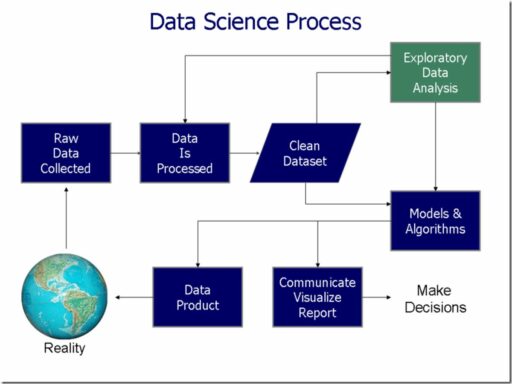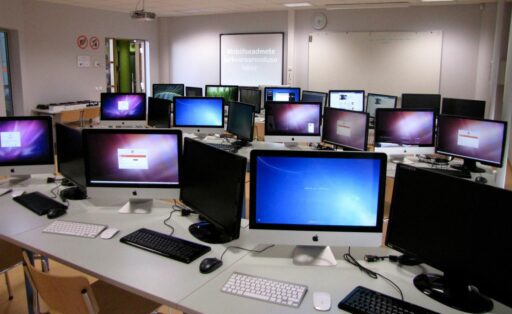Table of Contents
The iconic ‘Star Trek’ series has not only captivated audiences with its vision of the future but has also served as a catalyst for real-world technological advancements. From the development of AI and machine learning to the exploration of space and beyond, ‘Star Trek’ has inspired generations of scientists and engineers to turn science fiction into science fact. This article delves into the various ways that data and concepts from ‘Star Trek’ continue to influence and shape the trajectory of future tech innovations.
Key Takeaways
- ‘Star Trek’ has been a significant influence on the development of modern AI and machine learning, including predictive analytics, natural language processing, and ethical considerations.
- The series has acted as a blueprint for space exploration and technology, inspiring real-life spacecraft designs, concepts of teleportation, and a new generation of astrophysicists.
- Advancements in communication and information technology, such as holographic interfaces and advanced networking, can trace their roots back to ‘Star Trek’ innovations.
- Medical technologies, including portable diagnostic devices and telemedicine, have been directly influenced by the medical tools and concepts depicted in ‘Star Trek’.
- The societal impact of ‘Star Trek’ extends to the envisioning of data-driven utopias, AI governance, and the cultural acceptance of AI in our daily lives.
The Influence of ‘Star Trek’ on Modern AI and Machine Learning


Predictive Analytics and the Legacy of the Enterprise
The iconic starship Enterprise from ‘Star Trek’ was not just a vessel for exploration; it was a harbinger of the predictive analytics revolution. The Enterprise’s computer system, capable of analyzing vast amounts of data to inform decisions, mirrors today’s AI-driven analytics tools. These tools are essential for businesses seeking to navigate the complexities of the modern market.
- Predictive analytics in marketing optimizes customer engagement.
- Risk assessment models in finance forecast market trends.
- Healthcare analytics predict patient outcomes and improve care.
The journey of predictive analytics is akin to the voyages of the Enterprise: a continuous quest for knowledge, powered by data.
The evolution of predictive analytics has been marked by significant milestones, much like the episodic adventures of the Enterprise crew. From the early days of simple statistical models to the current landscape of deep learning and AI, the trajectory has been upward and outward, expanding the frontiers of what’s possible in business and beyond.
Natural Language Processing: From Universal Translators to Chatbots
The dream of a universal translator, as depicted in ‘Star Trek’, has long captured the imagination of technologists and linguists alike. Today, we see the realization of this concept through advanced natural language processing (NLP) systems that power chatbots and virtual assistants. These AI-driven entities are capable of understanding and responding to human language with increasing sophistication, making them invaluable in customer service, education, and personal assistance.
- Chatbots have evolved from simple scripted responses to dynamic conversational agents.
- Virtual Assistants like Siri and Alexa leverage NLP to interpret and act on user commands.
- Language Models such as GPT-3 demonstrate the ability to generate human-like text, pushing the boundaries of machine understanding.
The seamless interaction between humans and machines via natural language is a testament to the strides made in NLP, a field that continues to grow and surprise us with its potential.
The progression from the fictional universal translator to real-world applications has not been without challenges. Ethical considerations, language biases, and the need for contextual understanding are ongoing areas of research and development. As we refine these technologies, the goal remains to create systems that can answer novel questions and engage in meaningful dialogue, much like the universal translator on Star Trek.
Machine Learning Ethics: Lessons from Data and Android Rights
The ethical considerations of machine learning and AI are not just theoretical musings but practical concerns that must be addressed as these technologies become more integrated into society. The rights and treatment of androids in ‘Star Trek’, such as the character Data, mirror the current discourse on AI personhood and machine rights. As we create increasingly sophisticated AI, the line between machine and sentient being blurs, prompting questions about rights, responsibilities, and the ethical treatment of AI entities.
- Ethical AI design
- AI personhood debate
- Machine rights and responsibilities
The principles we establish today will set the precedent for future interactions with AI, much like the laws of Starfleet shaped the treatment of androids like Data.
The conversation around AI ethics is not just about preventing harm or misuse; it’s about shaping a future where AI and humans coexist harmoniously. The lessons from ‘Star Trek’ serve as a guide, reminding us that the values we embed in our technology today will define the society of tomorrow.
Space Exploration and Technology: The ‘Star Trek’ Blueprint


The Inspiration Behind Real-Life Spacecraft and Rovers
The legacy of ‘Star Trek’ extends beyond the screen, inspiring real-world engineers and scientists in the design and development of spacecraft and rovers. The visionary concepts of space exploration depicted in the series have been a catalyst for innovation. For instance, the sleek aesthetics and advanced functionalities of the Starship Enterprise have influenced the design principles of modern spacecraft.
- The Mars rovers, with their autonomous navigation and scientific instruments, echo the autonomous capabilities of ‘Star Trek’ vessels.
- Concepts like the shuttlecraft have paved the way for reusable space vehicles.
- The emphasis on modular design in ‘Star Trek’ can be seen in the International Space Station’s structure.
The exploration of space is not just about reaching new frontiers but also about the continuous improvement of technology through the remote data entry and analysis of different types of data. This iterative process is essential for enhancing our digital presence in the cosmos.
Teleportation and Quantum Entanglement: From Fiction to Reality
The concept of teleportation, once a staple of science fiction in ‘Star Trek’, is now being explored through the lens of quantum entanglement. Researchers are making strides in transmitting the state of a particle across distances, a fundamental step towards realizing teleportation. This process, while not yet applicable to human transportation, has significant implications for secure communication and quantum computing.
The principles of quantum mechanics that underpin teleportation are also unlocking new possibilities in data handling and transfer. As we venture into this uncharted territory, the potential for revolutionizing our digital infrastructure becomes increasingly tangible.
While the dream of stepping onto a transporter pad remains in the realm of imagination, the advancements in quantum physics suggest a future where the teleportation of information is commonplace. Here are some key developments:
- Quantum teleportation experiments successfully transferring the state of photons over kilometers.
- The use of entangled particles to create unbreakable encryption methods.
- Theoretical proposals for quantum networks that could outperform classical internet infrastructure.
Astrophysics and ‘Star Trek’: Influencing the Next Generation of Scientists
The allure of ‘Star Trek’ has long extended beyond its narrative to inspire real-world scientific pursuits, particularly in the field of astrophysics. The series has been a catalyst for many to explore the cosmos, seeking to turn science fiction into science fact. The impact on educational pathways is evident, with universities and research institutions fostering a new era of astrophysicists and engineers.
The dedication to scientific advancement and exploration seen in ‘Star Trek’ mirrors the commitment of today’s educational institutions to nurture the next wave of innovators.
The following list highlights key areas where ‘Star Trek’ has influenced astrophysics education and research:
- Encouragement of interdisciplinary studies combining physics, engineering, and computer science.
- Development of curricula that integrate theoretical knowledge with practical, hands-on experience.
- Fostering international collaborations and partnerships akin to the United Federation of Planets.
- Inspiring the creation of advanced research facilities and cutting-edge technology labs.
The ‘Star Trek’ Effect on Communication and Information Technology


Holographic Interfaces and the Push for Immersive Computing
The quest for immersive computing experiences has led to significant interest in holographic interfaces, a concept popularized by ‘Star Trek’. Holographic technology is no longer confined to the realm of science fiction, but is being actively developed for various applications. The tactile feedback in holographic systems, as seen on ‘Star Trek: Picard’, is a prime example of how the series has influenced current research into haptic technology.
In the Holodeck, the sensation of picking up a holographic stone is remarkably realistic. This is achieved through intricate force fields that simulate texture and weight, providing a user experience that is both visually and physically engaging. The development of such interfaces requires a multidisciplinary approach, combining advances in AI, material science, and sensory feedback mechanisms.
The integration of holographic interfaces into everyday technology could revolutionize the way we interact with data and with each other, offering a level of interactivity and presence that traditional screens cannot match.
While the full realization of these interfaces is still on the horizon, the progress made thus far is promising. Below is a list of key areas where holographic technology is making strides:
- Enhancing virtual and augmented reality experiences
- Improving remote collaboration tools
- Advancing educational and training simulations
- Enriching entertainment and gaming platforms
- Innovating in medical imaging and diagnostics
Subspace Communications: Paving the Way for Advanced Networking
The concept of subspace communications in ‘Star Trek’ has long fascinated fans and technologists alike, offering a vision of instantaneous, faster-than-light communication across vast distances. This fictional technology has inspired real-world research into quantum entanglement and advanced networking protocols.
In the realm of networking, the principles of subspace communications have led to innovative ideas about data transmission and connectivity. The pursuit of a network that can operate at unprecedented speeds and across global distances without latency is a direct reflection of the ‘Star Trek’ influence.
The drive to achieve a subspace-like communication network is not just about speed; it’s about creating a more interconnected and accessible world.
While we have yet to break the light-speed barrier in communication, the progress in fields such as quantum communication and satellite technology echoes the ‘Star Trek’ vision. The development of satellite constellations capable of providing global internet coverage is one such example, drawing parallels to the interconnectedness seen on the Enterprise.
- Quantum Communication Research
- Satellite Constellation Projects
- Global Internet Coverage Initiatives
- Advanced Networking Protocols
The journey from science fiction to science fact is ongoing, and ‘Star Trek’ continues to be a beacon for innovation, pushing the boundaries of what we believe is possible in communication technology.
The Evolution of Personal Devices: Tricorders to Smartphones
The journey from the fictional tricorder of ‘Star Trek’ to today’s smartphones is a testament to the show’s visionary impact. Smartphones now embody the multifunctional capabilities once ascribed to the tricorder, serving as communication devices, data collection tools, and portable sensors. The evolution of these devices reflects a broader trend in technology: the convergence of multiple functions into a single, portable form factor.
- Communication: From simple calls to complex social media interactions
- Data Analysis: Real-time processing and predictive analytics
- Health Monitoring: Sensors that track vital signs and diagnose ailments
The seamless integration of AI and machine learning into personal devices has revolutionized the way we interact with technology, making it more intuitive and responsive to our needs.
The proliferation of personal devices has also spurred discussions on data privacy and ethical use. As we continue to integrate these devices into every aspect of our lives, the conversation around Samsung data migration, and data collection strategies becomes increasingly pertinent. The future of personal devices is not just about technological advancement but also about navigating the complexities of data governance and user empowerment.
Medical Advancements Inspired by ‘Star Trek’ Innovations


The Tricorder Revolution: Portable Diagnostic Devices
The vision of the tricorder from ‘Star Trek’ has been a beacon for the development of portable diagnostic devices. Boldly going where no medical device has gone before, these handheld instruments are transforming healthcare by making diagnostics accessible in the field, far from traditional laboratories.
- Non-invasive sensors: Detect vital signs and body functions.
- Lab-on-a-chip technology: Analyzes samples for a range of conditions.
- Wireless connectivity: Shares data with medical facilities in real-time.
The convergence of miniaturization, sensor technology, and computational power has enabled the creation of devices that not only diagnose but also guide through the treatment process, much like the medical tricorder of ‘Star Trek’.
The impact of these advancements extends beyond convenience; it represents a paradigm shift in medical practice. Remote areas now have access to medical diagnostics that were once confined to well-equipped facilities. The implications for global health, particularly in resource-limited settings, are profound.
Regenerative Medicine and the Vision of a ‘Derma Regenerator’
The dream of regenerative medicine, as envisioned in ‘Star Trek’, is becoming more tangible with each scientific breakthrough. The concept of a ‘Derma Regenerator’, a device capable of healing wounds without scarring, is no longer pure science fiction. Researchers are actively exploring the intersection of AI, tissue engineering, and nanotechnology to create solutions that could one day mirror the instantaneous healing seen on the show.
The potential of these technologies extends beyond cosmetic repair, promising a future where regenerative treatments could replace traditional surgeries and long-term care.
While the full realization of a ‘Derma Regenerator’ is still on the horizon, the progress in this field is noteworthy:
- Advances in stem cell research and its application in skin regeneration.
- Development of bioprinting techniques for creating skin grafts on demand.
- Exploration of nanorobots for precision delivery of regenerative compounds.
- Integration of machine learning to predict and enhance healing processes.
Telemedicine and Remote Surgery: The Influence of Starfleet Medical
The vision of Starfleet Medical, with its advanced telemedicine and remote surgery capabilities, has been a beacon for modern healthcare innovation. Telehealth technologies are now pivotal in providing care to remote and underserved populations, echoing the inclusivity and reach of Starfleet’s medical ethos.
- Telehealth Training: Development of content and delivery using telehealth technologies.
- Policy Research: Focused on the impact of telehealth usage.
- Access Expansion: Supporting the growth of telehealth services.
- Consultative Resources: For stakeholders regarding telehealth.
The establishment of dedicated centers for telehealth, such as the Wyoming Center for Telehealth, signifies a commitment to integrating these futuristic concepts into today’s medical practices. The center aims to enhance training, research, and access to telehealth services, fostering a collaborative environment for healthcare professionals.
The transition to remote instruction and the exploration of integrity solutions for online exams reflect a broader shift towards digital engagement in education and healthcare. This shift is not only a response to current global challenges but also a step towards realizing the kind of future that Star Trek has always imagined.
The Societal Impact of ‘Star Trek’: Data-Driven Utopias and AI Governance


Envisioning a Post-Scarcity Economy: Replicators and Resource Management
The concept of a post-scarcity economy, as depicted in ‘Star Trek’, is a transformative vision where technology like replicators can create abundance, eliminating material scarcity. The potential for such technology to reshape our economic systems is profound, offering a glimpse into a future where resource management is driven by data and efficiency rather than scarcity.
In the ‘Star Trek’ universe, replicators are capable of creating almost anything from molecular patterns, suggesting a future where the need for traditional manufacturing and supply chains could be greatly reduced. This could lead to a significant shift in job markets, with new opportunities in fields like remote data entry and database management becoming more prevalent.
The shift towards a data-driven economy could democratize access to goods and services, making ‘luxuries’ readily available to all, thus redefining our understanding of wealth and value.
While the full realization of this technology remains in the realm of science fiction, the principles behind it inspire current advancements in 3D printing, automation, and AI. These innovations are laying the groundwork for a more efficient and equitable distribution of resources, potentially leading to a society that mirrors the egalitarian ethos of ‘Star Trek’.
AI Leadership and Ethics: The Role of Starfleet’s Prime Directive
The Prime Directive of Starfleet serves as a powerful ethical framework, one that resonates deeply with the current discourse on AI governance. It emphasizes non-interference and respect for the autonomy of sentient beings, a principle that is increasingly relevant as AI systems become more autonomous and integrated into society.
- Non-Interference: AI should not undermine human autonomy or decision-making.
- Respect for Autonomy: AI systems must be designed to respect the rights and dignity of all individuals.
- Beneficence: AI should be developed with the intent to do good and prevent harm.
- Justice: The benefits and burdens of AI should be distributed fairly across society.
The challenge lies in translating these lofty ideals into actionable policies that ensure AI systems are developed and deployed in a manner that upholds these values. The blueprint provided by science fiction, such as ‘Star Trek’, offers a starting point for envisioning the ethical landscape of future AI leadership.
The role of AI in leadership positions also raises questions about accountability and transparency. As AI systems take on more decision-making responsibilities, it becomes crucial to establish clear guidelines for their operation and oversight. The lessons from ‘Star Trek’ encourage us to consider the broader implications of AI and its potential to shape our future in profound ways.
Cultural Shifts and the Acceptance of AI in Daily Life
The integration of AI into the fabric of daily life has been a gradual but relentless process. The acceptance of AI has reached a point where its presence is as unremarkable as the smartphones in our pockets. From the way we interact with our home appliances to the personalized learning experiences enabled by large language models, AI has become a ubiquitous companion.
As AI continues to evolve, its applications become more profound and its integration more seamless. Companies like NTT Data and Samsung are at the forefront, simplifying life with AI through innovations in data migration, Big Data, and Business Intelligence. These advancements are not just about convenience; they represent a cultural shift towards a data-driven society where AI is a trusted tool for business growth and personal efficiency.
The future promises a landscape where AI liberates us from mundane tasks, reshaping the workforce and redefining leisure. The cultural acceptance of AI is mirrored in the entertainment we consume, the way we communicate, and the manner in which we learn and work.
The following list highlights some of the key areas where AI’s influence is palpable:
- Personalized learning and educational tools
- Home automation and smart appliances
- Business process optimization
- Healthcare and diagnostic advancements
- Entertainment and media creation
As we continue to navigate this new era, the conversation around AI ethics and governance becomes increasingly important. It is essential that we balance innovation with responsibility, ensuring that the benefits of AI are accessible to all and that its development is aligned with human values.
Conclusion
As we journey through the imaginative universe of ‘Star Trek’, we uncover a treasure trove of inspiration that fuels the fires of innovation in our own world. The series not only entertains but also projects a vision of technology that has, time and again, sparked real-world advancements. From the communicators that foretold today’s smartphones to the concept of universal translators paving the way for real-time language translation software, ‘Star Trek’ has been a guiding star for tech enthusiasts and innovators. The dialogue between science fiction and science fact is ongoing, with each new discovery and invention feeding back into the loop of creativity. The final frontier may be vast and unending, but so too is our potential to harness its imagined technologies, making the future an exciting realm of infinite possibilities.
Frequently Asked Questions
How has ‘Star Trek’ influenced the development of modern AI and machine learning?
‘Star Trek’ has been a source of inspiration for AI and machine learning through its portrayal of advanced technologies like the ship’s computer with natural language processing, predictive analytics, and ethical considerations in the form of android rights.
What ‘Star Trek’ technologies have inspired real-life space exploration?
Real-life spacecraft and rovers have been influenced by ‘Star Trek’s’ depiction of space exploration. The concept of teleportation has also sparked interest in quantum entanglement research, and the show has motivated many to pursue careers in astrophysics.
In what ways has ‘Star Trek’ impacted communication and information technology?
‘Star Trek’ has pushed the boundaries of communication and information tech with ideas like holographic interfaces, advanced networking akin to subspace communications, and the evolution of personal devices resembling tricorders.
What medical advancements have been inspired by ‘Star Trek’?
Medical devices such as portable diagnostic devices mirror the tricorder from ‘Star Trek.’ The show also envisioned regenerative medicine and telemedicine capabilities that have influenced current medical technology developments.
How does ‘Star Trek’ envision a data-driven utopia and AI governance?
‘Star Trek’ presents a post-scarcity economy with replicators managing resources efficiently, while the Prime Directive and Starfleet’s ethical guidelines offer a framework for AI leadership and governance.
What cultural shifts has ‘Star Trek’ initiated regarding the acceptance of AI in daily life?
‘Star Trek’ has helped normalize the integration of AI in society by showcasing its potential benefits and ethical use, paving the way for a cultural acceptance of AI as a beneficial component of daily life.





